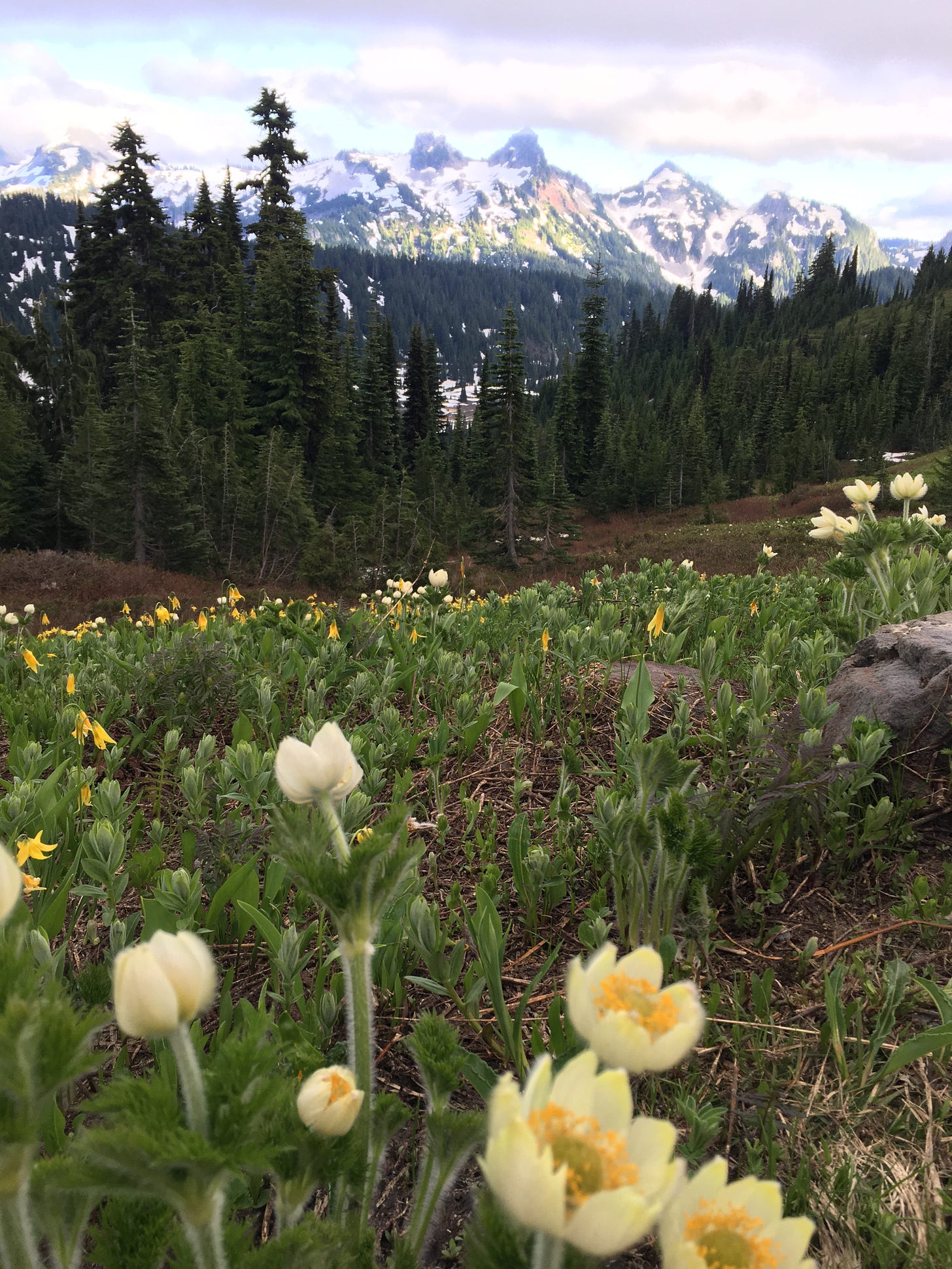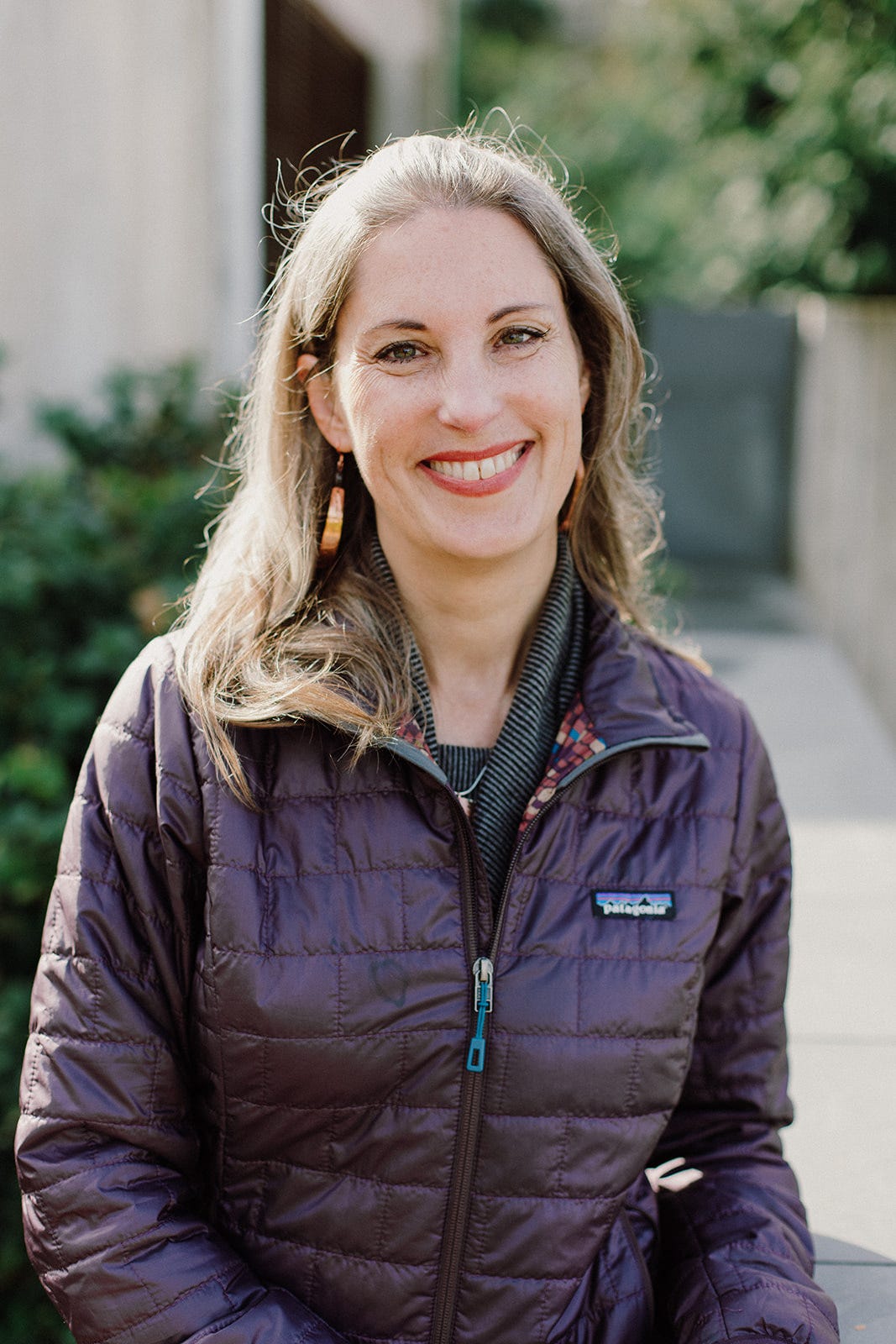🍃Reciprocity: the interview
6 questions for Suzanne Crawford O'Brien
Nature writer, n. A person who delights in paying attention, being astonished, and telling about it.1
“I’m convinced that our survival depends on our ability to understand what led us to (erroneously) think we can draw a line between ‘us’ and ‘nature,’ and to learn from those cultures and traditions that are still aware of the essential kinship we have with other-than-human beings.” ~ Suzanne Crawford O’Brien
My inbox is full of lovingly observed writing about place, encounters both wild and gentle, imaginative kinship and renewed reciprocity. These thoughtful, talented writers kindled in me the desire to learn more about them.
Today’s guest, Suzanne Crawford O'Brien, is a fourth generation Oregonian, born and raised under the towering conifers of the Cascade mountain range. She is a professor who teaches at the intersection of comparative religions, Native American studies and environmental studies at Pacific Lutheran University. Previous publications include Religion and Culture in Native America; Coming Full Circle: Spirituality and Wellness Among Native Communities in the Pacific Northwest; and Native American Religious Traditions. She lives with her family in Seattle, Washington.
Her Substack, Climate Anxiety and Spiritual Resilience, helps readers to navigate climate anxiety and transform our eco-grief and fear into compassion and opportunity. I was delighted to discover Suzanne’s clear-eyed truth-telling and expansive perspective, and I know you’ll enjoy her writing as much as I do. This fall, she’s been sharing weekly updates from her wonderful university course, titled—what else?—Climate Anxiety and Spiritual Resilience.
Why are you drawn to nature writing?
Because being in the natural world is where my heart sings. It’s where I feel most at peace, most inspired, and most spiritually alive. I grew up under big trees in the deep wilderness of the Cascade mountain range, and I don’t just love it, I’m in love with it. When I’m trying to figure out the whys of life, that’s where I go to look for answers, and where I’m most inspired.
Environmental justice (and I mean justice not just for human people but for all the planet’s plant and animal peoples) has been the primary driver throughout my academic career, both in the classes I teach and the books I write. It’s one of the primary reasons I found my way to Indigenous Studies, and why it’s remained the focus of my teaching and research.
I’m convinced that our survival depends on our ability to understand what led us to (erroneously) think we can draw a line between “us” and “nature,” and to learn from those cultures and traditions that are still aware of the essential kinship we have with other-than-human beings. I’m right there with Robin Wall Kimmerer and so many other Indigenous teachers and authors when they write that the plants (and animals) were our first teachers. They’re our older siblings. And we used to be really good at listening to and learning from them. We’ve got to re-learn that skill, reclaim that humility, if we want to continue to be part of this Earth community.
How does writing about nature affect you, in your work or personal life?
I write a lot these days about climate anxiety and eco-grief. I struggled mightily with these things myself—and I still do at times. It took my therapist to challenge me to start looking at what my own fields of study—Indigenous Studies and comparative religions and ecology—might have to offer by way of coping strategies. And I found so many resources! Writing began as a personal meditation, but I’m a teacher at heart, and it was a natural progression to sharing with others.
Getting outside and listening to what the natural world has to say is an essential part of my process, and it’s almost always where I can get to the heart of whatever I’m trying to say. The Native North American religious traditions that I teach about are incredibly diverse, and I always hate to make simplistic generalizations about them. But, one observation that I do feel pretty comfortable making is that Indigenous religious traditions share a focus on learning how to listen to and build respectful relationships with the more-than-human world. And, while I always caution against appropriating Indigenous religious practices, I am convinced that this is a universal teaching. This is something that we can all grow into and learn from: how to pay attention and listen to the natural world. The process of writing about nature is a beautiful reminder to get outside, to pay attention, to look for those lessons.
I do have to pause and just note how much I stumble each time I have to type the word “nature.” As I know you know, this is such a problematic word! It’s suggestion that we are somehow not essentially and inseparably a part of nature is part of our western European enlightenment/Protestant/capitalist/settler colonial heritage. As if there was somewhere a line I could draw between “us” and “the world out there.” But it’s hard to get away from the term, because we in our postmodern world do experience our existence as separate from the “natural” one—even if that experience is an illusion. And that illusion has done so much damage.
While outside, have you ever experienced feeling small, lost or in danger?
Once when I was in college, I decided to go for a solo hike on Mt. Jefferson in central Oregon. I did this a lot, and wasn’t too worried. It was early in the season—only late April, and the trail was around 3,000’ elevation—but I was sure I’d be fine. I left my 1982 Datsun at the trailhead, and headed up the mountain. After about a mile or so, I hit snow. I was energized and delighted with the solitude—I hadn’t seen anyone else on the road, no other cars at the trailhead. I felt like I had the mountain to myself. So I kept going. Then, I realized I had missed the track of the trail. I was lost. In the snow. Horrified, I realized that I had become the poster child for “what not to do.” I was alone. On a rarely used trail. No one knew where I was. I hadn’t packed anything. (I was dressed warmly but had only planned on a short 3-4 mile hike, and hadn’t brought any gear. Not even a bag of flippin’ trail mix.) I’d been hiking since I was in the womb—I knew better than this! Thank the goddess, I found my footprints and was able to follow them back to the trail, and back to my car. I can still remember the way my knees were shaking, the hollow feeling in my belly. I came so close to being one of those “lost hikers.” Lesson learned.
On another occasion, I was hiking around a lake just a couple hours away from Seattle. Halfway around, I had the distinct feeling that someone was there with me, that I was being watched. I’d never actually had the hair on the back of my neck stand up, but it did then. Goosebumps. I looked around, I thought I heard rustling, but it was a breezy day and hard to tell. Eventually, I just picked up the pace. When I got back to camp I was told that others had seen a bear along the trail, at that very spot. I didn’t see, hear, or smell her, but I was certain she’d seen me well enough.
What’s a favorite memory of nature from your childhood?
One of my earliest and clearest memories is a backpacking trip with my parents and older sister. I think I was around 4 years old. At this particular moment, they are packing up camp, preparing for us to head deeper into the Wallowa Mountains in northeastern Oregon. I’ve found a radiant spot of sunshine on a fallen log that serves as a natural bridge over a babbling brook. (In my memory, it is quite literally babbling.) The warm sunlight is refracting off the water, and I am snacking on some sugar cereal—a rare treat that we only got on camping trips. I am watching the way wildflowers bob and weave at the creek’s edge, tracing the lines left on the log by burrowing insects, feeling the warmth of the sunlight, hearing the trilling of birds, smelling that pine-sharp smell of alpine air. Whenever I hear someone talking about “going to your happy place,” this is where I go.
What do you hope for, for your writing?
My heart’s hope is that I can make some small contribution toward the much larger consciousness shift that I see happening as we wake up to climate change, and to the damage that extractive settler colonial economies have wreaked on our planet and on our own souls. I’ve been learning about and teaching about Indigenous traditions and the lessons of many other wisdom traditions for almost three decades. While I often struggle with a desire to jump ship from academia and “do something more practical,” I keep returning to the realization that there’s a deep hunger to reconnect with the natural world, with the spiritual (however that’s defined), and with a way of living where we know that each one of us matters—because we are all part of an interconnected whole. I really hope I can give folks some tools to help them transform their eco grief and climate anxiety into the practice of transformative resilience—of hope that looks like compassion in action.
A writer or other creative artist who makes you hopeful for humanity and the earth.
Cutcha Risling Baldy (Hupa/Yurok/Karuk) is an amazing scholar and author, whose work is right at the heart of efforts to revitalize young women’s coming of age ceremonies among northern California tribes. Her book We Are Dancing For You and her community-centered activism is seriously inspired. Her work is connected for me to all the incredibly exciting things that Klamath River tribes like hers are doing right now as the dams on the Klamath are coming down. These are communities that have experienced some of the most horrific violence of settler colonialism, who have been brutally hit by an epidemic of suicides, poverty, and drug abuse. And there is this beautiful synergy happening right now, as the river and these communities are rising up together. Check out https://www.facebook.com/TheYurokTribe and https://www.facebook.com/SaveCaliforniaSalmon to see some of what they're doing. It will put a smile on your face.
I am also inspired by anything Lila June Johnston does, absolutely loved Cole Arthur Riley’s This Here Flesh, and can’t stop recommending Ross Gay’s Inciting Joy. I also became familiar with the work of visual artist Kate Ahvakana (Suquamish/Iñupiaq) this year and cannot get enough. She’s amazing.
If you enjoyed this post, a lovely ❤️ keeps me going. Another way to show love is to share this post with others by restacking it on Notes, via the Substack app. Thanks!
For more inspired nature writing and artwork from the best of Substack, check out the articles in NatureStack journal.
🍃 04 | NatureStack: shared wonder
Intense energies are swirling here in the northern hemisphere. Last week brought the full supermoon partial lunar eclipse. Asteroid PT5 hitching a ride on earth’s gravitational pull has been called an “mini-moon.” I love that it detoured here from an asteroid belt named after Arjuna
In further service to Substack’s nature writers,
curates this lovely directory of nature-focused writers:thanks, Mary Oliver










I love how Suzanne states "The process of writing about nature is a beautiful reminder to get outside, to pay attention, to look for those lessons." I feel exactly the same way. I just recently visited a wildflower meadow where the Monarch butterflies stop over on their migration southward. I'd be honored if you'd care to read the post: https://inspireperspektive.substack.com/p/the-flight-of-the-monarch-eb5
Another great interview. These keep me inspired.
This, ".. learning how to listen to and build respectful relationships with the more-than-human world."